Salut! Baroque announces 2023 concert season, 23 January, 2023.
Salut’s 2023 concert series pays tribute to the art of improvisation and the fascinating phases and fashions of baroque music, read the article in Limelight.
Musicians were like the jazz greats of today, expected to improvise and ornament music spontaneously and with ‘good taste’, appropriate to the style and character of the piece. Musicians warmed to this freedom and performing music became a collaborative effort. Pity those needing prompting, with Roger North suggesting that notating ornaments “…is the hardest task that Can be, to pen the Manner of artificial Gracing the upper part. It hath bin attempted … but with Woeful Effect … therefore it is almost Inexcusable to attempt it.”
Salut! Baroque’s 2023 Concert Season, Inspiration & Improvisation , will explore the fascinating phases and fashions that baroque music ornamentation went through, sometimes without the composers themselves having a say in the way their music was being performed. Johann Joseph Fux (1725) protested that “excessive desire and audacity to vary has gone so far …[that] the composer is hard pressed to recognise his own composition.”
Salut!’s February concert, Cultural Journeys, celebrates music from Scotland to Istanbul, and Bohemia to Madrid with a musical journey inspired by Romani, Moorish and Celtic traditions and the Ottoman Empire. Music was an important part of these cultures, which incorporated singing, dancing and storytelling, and evoked expressions of love, joy and despair. Telemann drew inspiration and ideas “to last a lifetime” after hearing “36 Polish pipes and 8 Polish violins” improvising during his employment at the Court in Pless.
Singers of the Baroque period stirred the emotions of audiences, and Salut!’s April concert will transport listeners with Sweet Melodies and Angry Tempests. Composers relied on the nuance and intuitiveness of performers – Jacopo Peri (1600) wrote of ornaments as “those charms and elegances, which one cannot write down, and [if] written, one cannot learn them from the notation”. As singers saw opportunities to add flamboyant theatrics, some composers remained sticklers for restraint, with Lully declaring of his recitatives: “No embellishment! … I want it to be absolutely plain”. By the late Baroque period, composers began to regain control of their creative output, no longer leaving ornamentation to the discretion of the performers, and Marc-Antoine Laugier suggested musicians “restrict themselves scrupulously to the notation before their eyes” (1754).
JA Birnbaum’s (1738) warning that inappropriate ornamentation can “distress the ear markedly” is the focus of Salut!’s August concert, Corelli’s Magic. The 1710 publication of Arcangelo Corelli’s Opus 5 Violin sonatas by the publisher Estienne Roger included the adagio movements as originally written and also with ornaments “as [Corelli] plays them”. Amongst those who were dubious about this bold claim was Roger North who commented, “Some presumer hath published [ornaments in…] Corelly’s solos. … Upon the bare view of the print any one would wonder how so much vermin could creep into the work of such a master”. Yet even without verification, as a publisher’s marketing pitch, it was gold! The sonatas were reprinted dozens of times, and Quantz suggested in 1752 that “…cadenzas first came into use after the time Corelli published his twelve solos for the violin”.
Salut!’s October concert, The Cosmopolitans, explores how, behind seemingly effortless ornamentation, strict rules had to be observed to establish the character, emotion and aesthetics of the music. JS Bach commented that, “It is… somewhat strange that German musicians are expected to be capable of performing at once and ex tempore all kinds of music, whether it come from Italy or France, English or Poland”. Travelling musicians and composers pollinated new ideas across cultures but it was through the cosmopolitan Georg Muffat’s seminal work published in four languages, Florilegium primum (1695) and secundum (1698), that musicians became fluent in the language of French and Italian music, and “how to use, with judgment, beautiful decorations and appropriate ornaments, which light up the piece… like precious stones”.
Join Salut! Baroque for a year of sublime music as we travel across Europe and discover how improvision developed from individual expression to creative collaboration.



